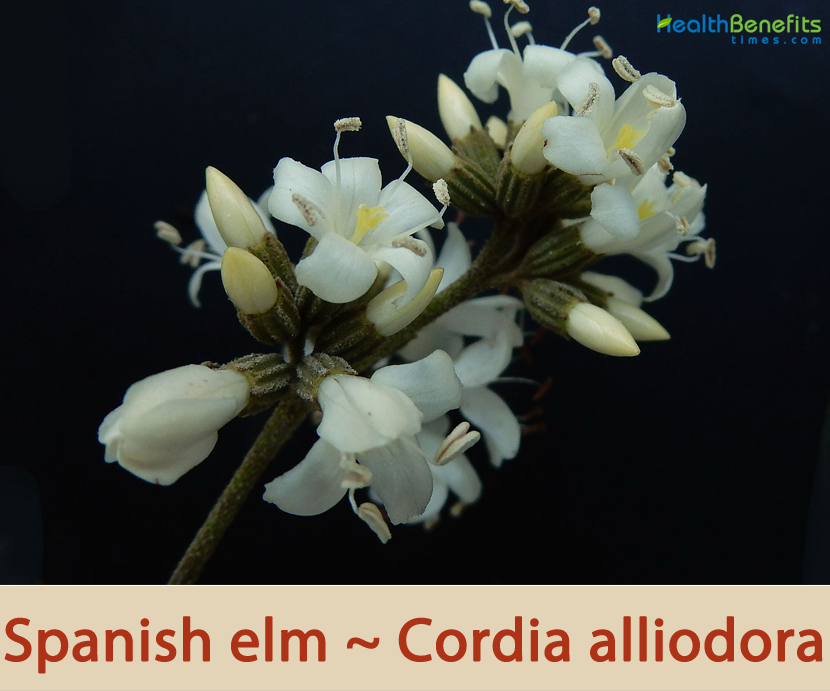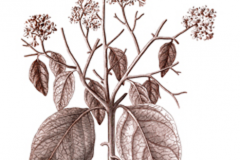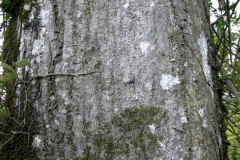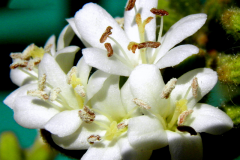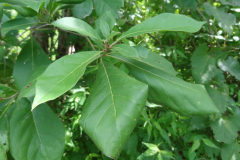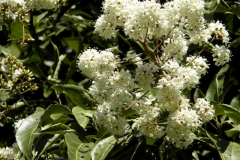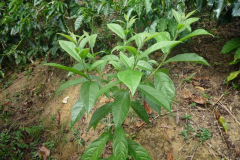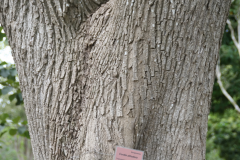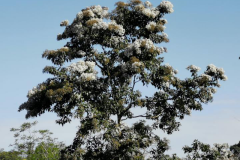| Spanish elm Quick Facts | |
|---|---|
| Name: | Spanish elm |
| Scientific Name: | Cordia alliodora |
| Origin | Mexico and the Antilles to Brazil and Bolivia |
| Shapes | Oblong, one-seeded, ellipsoid nutlet, 4.5-8 mm long and 1-2.5 mm wide, completely enveloped by the persistent corolla and calyx |
| Health benefits | Support catarrh, various lung ailments, wounds, edema, acne, burns, rashes, rheumatism, abscesses, tumors, tooth aches, bruises, swellings, myalgia, sciatica, asthma and tuberculosis |
| Name | Spanish elm |
|---|---|
| Scientific Name | Cordia alliodora |
| Native | Dry and wet forest from Mexico and the Antilles to Brazil and Bolivia. It is now widely distributed in tropical America from northern Argentina to central Mexico and in the Caribbean islands. It has been introduced to Africa, Asia (Nepal, Sabah and Sri Lanka) and the Pacific region (Hawaii, Solomon Islands and Vanuatu) |
| Common Names | Ecuador laurel, Spanish elm, cypre, laurel, salmwood, Onion Cordia, Laurel Blanco, Ecuador laurel, cordia, Brown silverballi, Satin wood, Silverballi, Manjack, Capá Prieto, pepino |
| Name in Other Languages | Belize: Bohun, corallilo, laurel blanco, salaam, salmwood Bolivia: Ajo, auxemma, lanza blanca, partago, picana, picana negra Brazil: Louro, louro amarello, uruazeiro Central America: Laurel Chinese: Suàn yè pò bù mù (算叶破布木) Colombia: Canalete de humo, laurel negro, moho, nogal, nogal cafetero, solera Costa Rica: Dze-u’, laurel negro Cuba: Var’a, var’a amarilla, var’a colorada, var’a prieta Dominica: Laurier Dominican Republic: Capá, capá de olor, capá de sabana, capá prieto, guacimilla Dutch: Knoflookboom Ecuador: Chaquine, laurel, laurel de monte, laurel de puna, laurel macho, laurel negro, laurel prieto, uurushi numi English: Brown silverballi, Salmwood, Satin wood, Silverballi, Spanish elm, Cypre, Manjack, Laurel, Capá Prieto, pepino, Ecuador laurel, onion cordia French: Bois de Chypre, Bois de Rhodes, Bois de rose, Bois saumée, Bois soumis, Chêne caparo, Cordie faux-bois-de-rose, Pardillo, cèdre Sam, burel blanco, cordia, onion cordia, salmwood, arbre à l’ail, sébestier à odeur d’oignon German: Lauch-Kordie Guadeloupe: Bois de Rhodes, bois de rose, bojon Guatemala: Chevel Guyana: Brown silver balli Haiti: Bois soumis, chne caparo Honduras: Laurel negro Jamaica: Smokewood, Spanish elm Martinique: Bois cypre, bois et roge Mexico: Aguardientillo, amapa, amapa asta (amapa hasta), amapa blanca, amapa bola, asca, boj—n, botoncillo, d’ou lemon, hochi, hormiguero, momiguilla, soleria (solerillo), solerito, suchil, suchil sabanero, tambor hormiguero Nicaragua: Cinchado, laurel macho, laurel negro Peru: Ajahatsa (ahahsatsa), anallo caspi, bolaina, chullachaqui blanco, tama palo santo Portuguese: Falso-louro, Freijó-branco, freijó preto, Lourinho, Louro-alho, Louro-amarelo, Louro-branco, Louro-negro, Teijo, Urazeiro, Uruá, Uruazeiro, Freijó, freijorge, loureiro-amarelo Puerto Rico: Cayly, cypre, mu–eco Quechua: Ahus k’aspi Russian: Kordiia lukopakhnushchaia (Кордия лукопахнущая) Samoan: Kotia Spanish: Ajo ajo, Alatrique, Arbol del ajo, Baría aguacate, Baría amarilla, Baría colorada, Canalete, Capá, Capá de olor, Capá de sabana, Capá prieta, Capá prieto, Caparó, Guacimilla, capa prieto; cypre; laurel, Laurel blanco, Laurel de costa, Laurel de savana, Laurel hembra, Laurel hormiguero, Laurel macho, Laurel negro, Nogal cafetero, Nogal de cafelatés, Nogal de cafetal, Nogal de cafetales, Nogal de cafetero, Nogal de capelates, Palo de rosa del país, Picana negra, Poma rosa, Popocotle, Tambor hormiguero, Varía, Varía aguacate, Varía blanca, Varía colorada, Varía prieta Swedish: Salmträd Tongan: Kotia Trinidad and Tobago: Cyp, cypre, cypress Venezuela: Mataatiyo, pardillo, tacura’, utaatigo |
| Plant Growth Habit | Small or medium-sized, fast-growing tropical semi-evergreen tree |
| Growing Climates | Lowland to highland forests, dry forests, forest edges, gaps, thickets and occasionally in wet, mixed forest or along roadsides |
| Soil | Grows best on well-drained, medium-textured soils and does not tolerate either poor internal drainage or water-logging. It is particularly suitable for calcareous soils in the more humid tropics. It is not exacting in nutrient requirements, adapting well to degraded and abandoned areas once used for row crops, pasture, or shifting cultivation |
| Plant Size | Height of over 40 m, and a diameter at breast height (dbh) of over 1 m at over maturity, although diameters of around 50 cm are more usual for mature trees. In seasonally dry deciduous and semi-deciduous forest, it is smaller and more poorly formed, rarely reaching more than 20 m in height and 30 cm dbh |
| Root | Develop a strong taproot. Later, spreading roots also develop which may grow into buttresses |
| Bark | Bark of young trees smooth and greenish, becoming greenish-black and sometimes narrowly fissured with age. Although in drier regions it tends to be more fissured. In many cases the light color is enhanced by the presence of lichens on the bark, such that from a distance the tree has a striking white trunk |
| Twigs | Twigs stellate-pubescent when young, ending in obovoid ant domatia |
| Leaf | Leaves are simple, petiolate, and alternate, up to 18 cm in length and 5 cm in width, short or long-pointed at the base. Leaf blades are oblong or lance-shaped (lanceolate) to oval (elliptic). Upper leaf surface may have scattered hairs when young, but is smooth at maturity, lower leaf surface covered with stellate hairs. |
| Flowering season |
|
| Flower | Flowers are hermaphroditic, unspecialized, about 1 cm in length and wide, white. Calyx is tubular, 4-6 mm long, grey-green, 10(-12)-ribbed, 4-6 toothed, densely stellate hairy. Corolla is tubular, 4-6 lobed, up to 14 mm long, white, tube up to 8.5 mm long, lobes oblong and rounded, spreading, up to 8.5 mm long |
| Fruit Shape & Size | Oblong, one-seeded, ellipsoid nutlet, 4.5-8 mm long and 1-2.5 mm wide, completely enveloped by the persistent corolla and calyx |
| Propagation | By seed or by stem cuttings |
| Season | September to April |
| Culinary Uses |
|
Plant Description
Spanish elm is a small or medium-sized, fast-growing, tropical semi-evergreen tree that normally grows over 40 m, and a diameter at breast height (dbh) of over 1 m at over maturity, although diameters of around 50 cm are more usual for mature trees. In seasonally dry deciduous and semi-deciduous forest, it is smaller and more poorly formed, rarely reaching more than 20 m in height and 30 cm dbh. The plant is found growing in lowland to highland forests, dry forests, forest edges, gaps, thickets and occasionally in wet, mixed forest or along roadsides. The plant grows best on well-drained, medium-textured soils and does not tolerate either poor internal drainage or water-logging. It is particularly suitable for calcareous soils in the more humid tropics. It is not exacting in nutrient requirements, adapting well to degraded and abandoned areas once used for row crops, pasture, or shifting cultivation.
The plant develops a strong taproot. Later, spreading roots also develop which may grow into buttresses. It has a compact crown and straight stem, and is capable of self-pruning. The trunk is smooth and light coloured. Outer bark of young trees is smooth and greenish, becoming greenish-black and sometimes narrowly fissured with age. Although in drier regions it tends to be more fissured. In many cases the light color is enhanced by the presence of lichens on the bark, such that from a distance the tree has a striking white trunk. Inner bark is light brown, fibrous, and tasteless. It gives off a slight odor of garlic, a fact that promoted its scientific name.
Leaves
Leaves are simple, petiolate, and alternate, up to 18 cm in length and 5 cm in width, short or long-pointed at the base. Leaf blades are oblong or lance-shaped (lanceolate) to oval (elliptic). Upper leaf surface may have scattered hairs when young, but is smooth at maturity, lower leaf surface covered with stellate hairs. Petioles are 1-2 cm long, slender, sparsely hairy, like the greenish twigs.
Flowers
Flowers are perfect and crowded on a widely branched terminal panicle 10 to 30 cm (3.9 to 11.8 in) across, branches usually densely stellate-pubescent; pedicel up to 1.5 mm long. Auxiliary terminal inflorescence has flowers as few as 50 up to as many as 3000.
Flowers are hermaphroditic, unspecialized, about 1 cm in length and wide, white. Calyx is tubular, 4-6 mm long, grey-green, 10(-12)-ribbed, 4-6 toothed, densely stellate hairy. Corolla is tubular, 4-6 lobed, up to 14 mm long, white, tube up to 8.5 mm long, lobes oblong and rounded, spreading, up to 8.5 mm long. There are five white stamens that are erect and protrude well beyond the exserted style, which is two-forked, each fork having two broad stigmas.
Fruits
Fertile flowers are followed by ellipsoid nutlet, 4.5-8 mm long and 1-2.5 mm wide, completely enveloped by the persistent corolla and calyx, the wall thin and fibrous. The fruit ripen within 1 to 2 months after flowering commences. Nutlets are oblong, one-seeded, about 6 mm (0.25 in) long. Seeds are wind dispersed, yet they can persist on the trees a few weeks after ripening. Seed fall is usually quite variable since laurel flowers throughout the year. In Central America maximum seed fall is usually in April and May.
Traditional uses and benefits of Spanish Elm
- The leaves are used medicinally particularly in the treatment of catarrh and various lung ailments.
- The leaves are stimulant, stomachic and tonic.
- An ointment made from the pulverized seeds is used in the treatment of skin diseases.
- Its root is used as a medicinal plant by natives living in the Peruvian Amazon forest.
- Roots are said to have substances which have anti-microbial and anti-fungal properties.
- Bark is used for wounds, edema, acne, burns, rashes, rheumatism, antispasmodic, as an emetic and diuretic.
- Stalk is used in intestinal diseases, as an anti-inflammatory for abscesses and tumors, tooth aches.
- Leaves are cooked to be used as tonics and stimulants, particularly for colds and lung problems.
- Salves are produced from crushed seeds to cure skin diseases.
- A paste of the leaves is applied topically to treat bruises and swellings.
- In Ecuador, the young shoot paste is used as an antiseptic in wounds and sore.
- In Latin America the alcoholic bark extract is used in the form of massage to release pain, myalgia and sciatica.
- Leaf tea is used as a tonic in asthma and tuberculosis.
Different Products
- Food: The fruits are edible but not very tasty.
- Apiculture: Flowers are a major source of viscous, extra-white honey.
- Timber: A renowned timber-producing species. The wood is usually straight grained, easy to work to a smooth finish, with little dulling of cutting edges. The wood is used for building construction, flooring, furniture and veneer manufacture, boat timbers, oars, rail sleepers, turnery, scientific equipment, and a wide variety of carvings and artists’ equipment. The wood is resistant to decay; it has some resistance to marine borers and is outstandingly resistant to termite attack.
- Medicine: A decoction of the leaves is used as a tonic and a stimulant, especially in cases of catarrh and lung infection. Pulverized seeds are used in the treatment of cutaneous diseases.
Various Services
- Shade or shelter: Grown as a shade tree for coffee and cocoa plantations and in pastures, often in combination with Erythrina poeppigiana. Plantations exposed to hurricanes and cyclones have shown above-average resistance to stem break and wind throw.
- Soil improver: Improved nutrient recycling is brought about by growing C. alliodora in coffee plantations.
- Ornamental: The tree is planted as an ornamental because of its attractive, abundant, white, fragrant flowers.
- Intercropping: It is a good tree for combining with crops. It has been incorporated with pasture, often in mixture with woody species of Erythrina. It has also been grown with sugarcane.
Management of Spanish Elm
The precise management measures adopted for any plant invasion will depend upon factors such as the terrain, the cost and availability of labor, the severity of the infestation and the presence of other invasive species.
The best form of invasive species management is prevention. If prevention is no longer possible, it is best to treat the weed infestations when they are small to prevent them from establishing (early detection and rapid response). Controlling the weed before it seeds will reduce future problems. Control is generally best applied to the least infested areas before dense infestations are tackled. Consistent follow-up work is required for sustainable management.
Control is very difficult as plants sprout readily from cut stems. The editors could not find any information on chemical or biological control of this species.
Other Facts
- The tree is planted as an ornamental because of its abundant, attractive, white, fragrant flowers.
- It is wind resistant and readily inhabits bare soil making it an ideal pioneer species.
- Wood is moderately durable, resistant to fungus and termites attacks, and produces an attractive finish.
- The species frequently serves as shade for coffee trees and farm animals.
- Wood is easy to work and the dark colored heartwood is a favorite of woodworkers for fine carpentry.
- Wood is used in construction for making doors, window frames, paneling, flooring etc.; it is also used for furniture, cabinet work, turnery, carving, scientific instruments, boats (including bridge decking), oars, sleepers, veneer, fuel wood and charcoal.
- Smaller branches are used for making barrel hoops.
- The wood is used for fuel and making charcoal.
- The crushed leaves and the fresh bark smell of garlic.
- Its flowers are known to bee-keepers as a major source of nectar.
- The weight of 1000 seeds is 15-50 g.
- Flowering may start when the trees are only 2 years old, but more commonly between 5-10 years after planting.
References:
https://www.itis.gov/servlet/SingleRpt/SingleRpt?search_topic=TSN&search_value=31751#null
http://www.hear.org/pier/species/cordia_alliodora.htm
https://pfaf.org/User/Plant.aspx?LatinName=Cordia+alliodora
https://www.cabi.org/isc/datasheet/15353
http://www.theplantlist.org/tpl1.1/record/kew-2736526
https://uses.plantnet-project.org/en/Cordia_alliodora_(PROSEA)
https://en.wikipedia.org/wiki/Cordia_alliodora
https://gd.eppo.int/taxon/CRHAD
https://tropical.theferns.info/viewtropical.php?id=Cordia+alliodora
https://apps.worldagroforestry.org/treedb/AFTPDFS/Cordia_alliodora.PDF
https://plants.usda.gov/home/plantProfile?symbol=COAL


